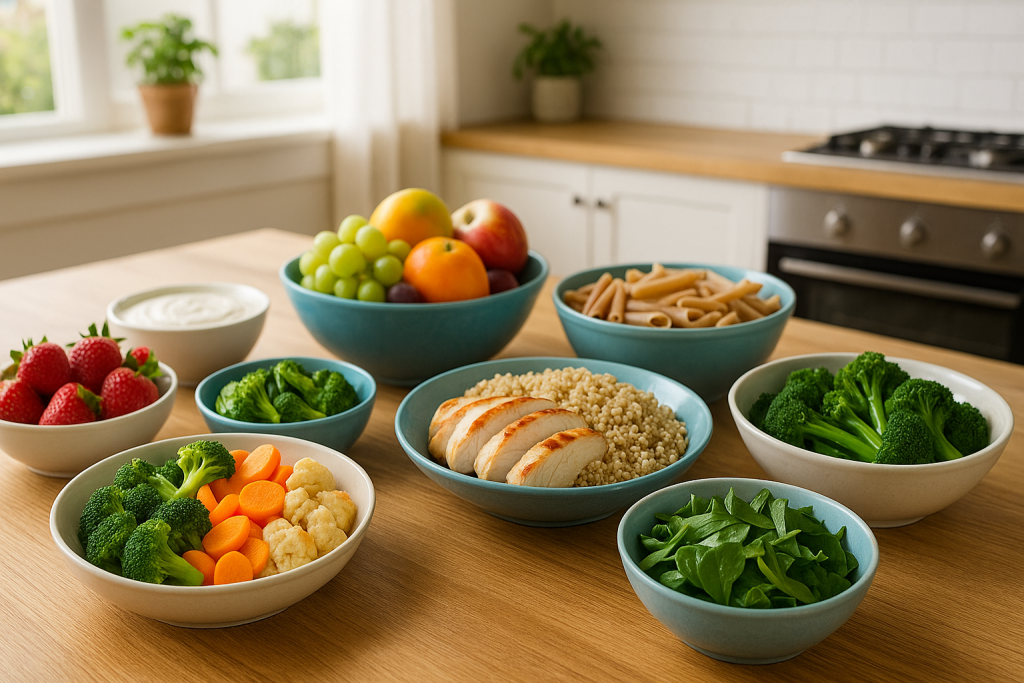Healthy Family Meals: 7 Simple Steps for Nutritious Cooking
Why Prioritizing Healthy Family Meals Matters
Making healthy meals for your family is more important than ever. With rising rates of obesity and chronic health conditions, prioritizing nutrition at home can help your loved ones avoid long-term health issues, boost energy, and improve overall wellness. According to the CDC, children who eat balanced meals are more likely to have healthier body weights, better academic performance, and improved moods.
Beyond the physical benefits, sharing wholesome meals together as a family strengthens your bonds. Studies show that families who eat together regularly communicate better and develop healthier relationships. Committing to nutritious home-cooked meals is an investment in your family’s future.
Step 1: Master the Basics of Balanced Nutrition
Understanding the Food Groups

Start by building every meal around the five essential food groups:
- Vegetables: Provide fiber, vitamins, and minerals. Go for a variety of colors.
- Fruits: Offer natural sweetness and nutrients. Fresh or frozen are best.
- Whole grains: Brown rice, quinoa, and whole-wheat pasta offer lasting energy.
- Lean proteins: Chicken, fish, beans, eggs, and tofu build and repair tissues.
- Dairy or alternatives: Milk, yogurt, and non-dairy options supply calcium.
Portion Control and Moderation
Portion sizes often get overlooked. Use smaller plates, serve appropriate amounts, and encourage family members to listen to their hunger and fullness cues. This helps prevent overeating and teaches children healthy habits for life.
Step 2: Plan Your Meals Ahead
Creating a Weekly Meal Plan

Meal planning is the secret weapon of families who eat healthy consistently. Take time each week to write down your breakfasts, lunches, dinners, and snacks. This reduces stress during busy evenings and helps you avoid last-minute unhealthy takeout.
- Include a mix of protein, grains, and vegetables in every meal
- Rotate family favorites to keep things interesting
- Plan for leftovers to save time and money
Involving the Family in Planning
Get the whole family involved! Ask kids to suggest meals or help choose veggies at the store. When children have a say, they’re more likely to try new foods and feel invested in mealtime.
Step 3: Shop Smart for Success
Make a Grocery List and Stick To It
Going into the grocery store with a list helps you avoid impulse buys and focus on healthy ingredients. Organize your list by categories (produce, proteins, grains) for a faster trip.

Choose Whole, Fresh Ingredients
Shop the perimeter of the store for fresh produce, lean meats, and dairy. Limit processed foods and snacks high in sugar or fat. Instead, stock up on:
- Seasonal fruits and vegetables
- Whole grains like oats, brown rice, and barley
- Lean meats, fish, beans, and tofu
- Healthy fats such as nuts, seeds, and olive oil
Buying in bulk where possible can also reduce costs and ensure you always have healthy staples on hand.
Step 4: Prep and Cook Efficiently
Batch Cooking and Meal Prepping
Save time during the week by batch cooking ingredients or entire meals on weekends. Cook a large batch of brown rice, grill chicken breasts, or chop veggies in advance. Store in airtight containers for easy assembly later.

Quick, Healthy Cooking Techniques
Opt for methods like baking, grilling, steaming, or sautéing instead of frying. These techniques use less oil and preserve nutrients:
- Sheet pan meals: Roast proteins and veggies together with herbs for minimal cleanup.
- Slow cooker or Instant Pot: Perfect for making stews, soups, or shredded chicken without much effort.
- Stir-frying: Keeps vegetables crisp and meals fast!
Step 5: Make Meals Appealing to Kids
Encouraging Picky Eaters
Children can be hesitant to try new foods, especially vegetables. Present meals in a fun, colorful way—create “rainbow plates” or use cookie cutters for sandwiches and fruit. Offer new foods alongside familiar favorites.
Get Kids Involved in Cooking
Invite your children to wash produce, mix ingredients, or set the table. Kids are more likely to eat what they’ve helped prepare and learn valuable cooking skills.
Step 6: Healthy Meal Ideas for Busy Families
Quick and Nutritious Recipes
Not sure what to make? Here are a few easy, balanced meal ideas your family will love:
- Grilled chicken with roasted vegetables and quinoa
- Whole wheat pita pizzas with tomato sauce and mixed veggies
- Vegetarian chili with beans, corn, and bell peppers
- Stir-fry with lean beef, broccoli, carrots, and brown rice
- Oven-baked salmon with sweet potato and a green salad
Time-Saving Breakfast and Snack Options
Healthy options don’t have to take long:
- Overnight oats with fruit and seeds
- Yogurt parfaits with granola and berries
- Veggie omelets or egg muffins for grab-and-go
- Apple slices with nut butter
- Hummus with carrot or cucumber sticks
Step 7: Building Long-Term Healthy Habits
Consistency Over Perfection
Remember that no one eats perfectly all the time. The key to lasting change is consistency. Aim to make healthy choices most of the time, and don’t stress over occasional treats or busy nights.
Celebrate Small Wins as a Family
Acknowledge your progress, whether it’s trying a new vegetable, cooking together, or eating at the table more often. Celebrating these small milestones motivates everyone to keep making healthy choices.
Common Challenges and Solutions
Dealing with Time Constraints
Busy schedules can make home-cooked meals seem impossible. Combat this by:
- Prepping ingredients in advance
- Using a slow cooker for hands-off cooking
- Choosing simple, few-ingredient recipes
Sticking to Your Budget
Healthy eating doesn’t have to be expensive. Shop seasonal produce, use beans or lentils to stretch meals, and plan leftovers to reduce waste. Compare prices and buy in bulk when practical.
Conclusion: Start Cooking Healthier Today
Preparing healthy meals for your family is completely achievable, even with a busy lifestyle. By following these 7 proven steps—understanding nutrition, planning ahead, shopping smart, efficient cooking, making meals appealing, trying new recipes, and building lasting habits—you’ll make nutritious eating a normal part of family life.
Begin with small changes, stay consistent, and watch your family thrive with better health, more energy, and stronger connections around the dinner table.


